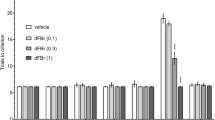Abstract
Four experiments compared the CNS effects of a novel M1/M3 receptor agonist L-689,660 with those of the M1/M3 muscarinic receptor agonist AF102B. In the mouse tail-flick test of antinociception (TF) the minimum effective doses to increase tail-flick latency (MED) of L-689,660 and AF102B were 0.03 mg/kg and 10.0 mg/kg, respectively. In a rat conditioned-suppression-of-drinking (CSD) test of reference memory, doses of 0.3 and 1.0 mg/kg L-689,660 and a dose of 5.0 mg/kg AF102B reversed a scopolamine-induced deficit in performance (0.6 mg/kg). Although there was a tendency for L-689,660 to reverse the scopolamine-induced (0.4 mg/kg) performance deficit in a rat delayed-matching-to-position (DMTP) test, the difference failed to reach statistical significance. In contrast, a 5.0 mg/kg dose of AF102B potentiated the scopolamine-induced deficit in choice accuracy and the number of trials completed on this task. In a response sensitivity (RS) test, chain-pulling rates were significantly decreased by L-689,660 (MED=0.03 mg/kg) and by AF102B (MED=5.0 mg/kg). These results suggest that L-689,660 and AF102B may ameliorate or reverse a scopolamine-induced deficit, but only at doses that also reduce chain-pulling rates on operant schedules of reinforcement.
Similar content being viewed by others
References
Baker R, Street LJ, Reeve AJ, Saunders J (1991) Synthesis of azabicyclic pyrazine derivatives as muscarinic agonists and the preparation of a chloropyrazine analogue with functional selectivity at subtypes of muscarinic receptors. J Chem Soc Chem Commun 11:760–762
Bartus RT (1978) Evidence for a direct cholinergic involvement in scopolamine-induced amnesia in monkey: effects of concurrent administration of physostigmine and methylphenidate with scopolamine. Pharmacol Biochem Behav 9:833–836
Bartus RT, Dean RL (1988) Tetrahydroaminoacridine, 3,4-diaminopyridine and physostigmine: direct comparison of effects on memory in aged primates. Neurobiol Aging, 9:351–356
Bonner TI, Buckley NJ, Young AC, Brann MR (1987) Identification of a family of muscarinic acetylcholine receptor genes. Science 237:527–532
Bowen DM, Smith CB, White P, Davidson AN (1976) Neurotransmitter-related enzymes and indices of hypoxia in senile dementia and other abiotrophies. Brain 99:459–496
Brandeis R, Dachir M, Sapir A, Levy A, Fisher A (1990) Reversal of age related cognitive impairments by an M1 cholinergic agonist, AF102B. Pharmacol Biochem Behav 36:89–95
Buckley NJ, Bonner TI, Young AC, Brann MR (1989) Antagonist binding properties of five cloned muscurinic receptors expressed in CHO-KI cells. Mol Pharmacol 35:469–476
Davis P, Maloney AJ (1976) selective loss of central cholinergic neurons in Alzheimer's disease. Lancet 2:1403
Dawson GR, Bentley G, Draper F, Rycroft W, Iversen SD, Pagella PG (1991) The behavioral effects of heptyl physostigmine a new cholinesterase inhibitor, in tests of long-term and working memory in rodents. Pharmacol Biochem Behav 39:865–871
Dunnett SB, Evenden JL, Iversen SD (1988) Delay-dependent short-term memory deficits in aged rats. Psychopharmacology 96:174–180
Dunnett SB, Everitt BJ, Robbins TW (1991) The basal forebraincortical cholinergic system: interpreting the functional consequences of excitotoxic lesions. TINS 14:494–504
Eagger SA, Levy R, Sahakian BJ (1991) Tacrine in Alzheimer's disease. Lancet 337:989–992
Fibiger HC (1991) Cholinergic mechanisms in learning, memory and dementia: a review of recent evidence. TINS 14:220–223
Fisher A, Brandeis R, Karton I, Pittel Z, Gurwitz D, Haring R, Sapir M, Levy A, Heldman E (1991) (+)-cis-2-Methyl-spiro(1,3-oxathiolane-5,3′) quinuclidine, an M1 selective cholinergic agonist, attenuates cognitive dysfunctions in an animal model of Alzheimer's disease. J Pharmacol Exp Ther 257:392–403
Freedman SB, Patel S, Marwood R, McKnight AT, Newberry N, Hurley CJ, Hill RG, Hargreaves RJ (1991) The pharmacology in vivo of L-689,660, a functionally selective M1/M3 muscarinic agonist. Br J Pharmacol 104:109P
Ghelardini C, Malmberg-Aiello P, Giotti A, Malcangio M, Bartolini A (1990) Investigation into atropine-induced antinociception. Br J Pharmacol 101:49–54
Hargreaves RJ, McKnight AT, Scholey K, Newberry N, Street L, Hutson P, Semark J, Harley EA, Patel S, Freedman SB (1992) L-689,660 a novel cholinomimetic with functional selectivity for M1 and M3 receptors. Br J Pharmacol 107:494–501
Harris LS, Pierson AK (1964) Some narcotic antagonists in the benzomorphan series. J Pharmacol Exp Ther 143:141–148
Kenakin TP (1986) Tissue and receptor selectivity: similarities and differences. Adv Drug Res 15:71–109
Morris RG, Kopelman DM (1986) The memory deficits in Alzheimer-type Dementia: a review. Q J Exp Psychol 38A:575–602
Mouradian MM, Mohr E, Williams JA, Chase N (1988) No response to high-dose muscarinic agonist therapy in Alzheimer's disease. Neurology 38:606–608
Murray TK, Cross AJ, Green AR (1991) Reversal by tetrahydroaminoacridine of scopolamine-induced memory and performance deficits in rats. Psychopharmacology 105:134–136
Nakahara N, Iga Y, Mizobe F, Kawanishi G (1988) Amelioration of experimental amnesia (passive avoidance failure) in rodents by the selective M1 agonist AF102B. Jpn J Pharmacol 48:502–506
Peralta EG, Askenazi A, Winslow JW, Smith DH, Ramachran J, Capon DJ (1987) District primary structures, ligand binding properties and tissue-specific expression of four human muscarinic acetylcholine receptors. EMBO J 6:3923–3929
Perry EK, Perry RH, Blessed G, Tomlinson BE (1977) Necropsy evidence of central cholinergic deficits in senile dementia. Lancet 1:189
Podlisny MB, Tolan DR, Selkoe DJ (1991) Homology of the amyloid β protein precursor in monkey and human supports a primate model for β amyloidosis in Alzheimer's disease. Am J Pathol 138:1423–1435
Preston GC, Brazell C, Ward C, Broks P, Traub M, Stahl SM (1988) The scopolamine model of dementia: determination of central cholinomimetic effects of physostigmine on cognition and biochemical markers in man. J Psychopharmacol 2:67–79
Sarter M, Hagan J, Dudchenko P (1992a) Behavioural screening for cognition enhancers: from indiscriminate to valid testing. Part I. Psychopharmacology 107:144–159
Sarter M, Hagan J, Dudchenko P (1992b) Behavioural screening for cognition enhancers: from indiscriminate to valid testing. Part II. Psychopharmacology 107:461–473
Author information
Authors and Affiliations
Rights and permissions
About this article
Cite this article
Dawson, G.R., Bayley, P., Channell, S. et al. A comparison of the effects of the novel muscarinic receptor agonists L-689,660 and AF102B in tests of reference and working memory. Psychopharmacology 113, 361–368 (1994). https://doi.org/10.1007/BF02245210
Received:
Revised:
Issue Date:
DOI: https://doi.org/10.1007/BF02245210




